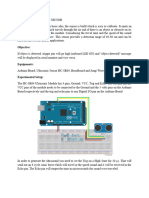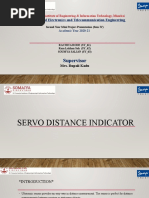Arduino with LCD
Uploaded by
manojdhawan2017Arduino with LCD
Uploaded by
manojdhawan2017Aim: Calculate the distance to an object with the help of an ultrasonic sensor and display it on an LCD
Procedure:-In this experiment, we are going to interface Ultrasonic sensor HC-SR04 with Arduino and LCD Display. The ultrasonic sensor is
used to measure the distance. It acts as a Sonar. It sends an ultrasonic wave of a certain frequency that comes back after hitting the object
and calculates the time traveled by it. So let’s learn about Distance Measurement Using Arduino & HC-SR04 Ultrasonic Sensor.
Components Required: 1. Arduino Uno Board 2. Ultrasonic Sensor HC-SR04 3. 16*2 LCD Display 4. Breadboard 5. Connecting Wires
6. 5V Power Supply 7.Ultrasonic Sensor HC-SR04:
Description:-The HC-SR04 ultrasonic sensor uses sonar to determine the distance to an object like bats do. It offers excellent non-contact
range detection with high accuracy and stable readings in an easy-to-use package. Distance Measurement Using Arduino & HC-SR04 From
2cm to 400 cm or 1” to 13 feet. Its operation is not affected by sunlight or black material like sharp rangefinders are (although acoustically
soft materials like cloth can be difficult to detect). It comes complete with the ultrasonic transmitter and a receiver module.
The specifications of the ultrasonic distance sensor HC-SR04 are below:- 1. Minimum measuring range – 2 cm 2. Maximum measuring
range: 400 cm or 4 meter 3. Accuracy: 3 mm 4. Operating Voltage: +5V 5. Operating Current: 15mA 6. Working Frequency: 40
KHz 7. Trigger Input signal: 10us pulse 8. Measuring angle: 15 degrees Pins: 8 1. VCC: +5VDC 2. Trig: Trigger (INPUT) 3. Echo: Echo
(OUTPUT) 4. GND: GND
Working Procedure:-Ultrasonic sensors emit short, high-frequency sound pulses at regular intervals. These propagate in the air at the
velocity of sound. If they strike an object, then they are reflected back as echo signals to the sensor, which itself compute the distance to the
target based on the time-span between emitting the signal and receiving the echo. We will have to convert this time into cm to calculate the
distance traveled. We will use the following equation to calculate the distance. s = v * t The ultrasonic wave is basically a sound wave that
travels at a speed of 340 m/s (0.034 cm/s). The ultrasonic sensor is measuring the time it takes to hit the object and then come back but we
need only time that it takes to hit the object. So, we will divide it by 2.
Circuit Diagram and Connections
Trig and Echo pins of the ultrasonic sensor are connected to digital pin 3 & 2 of Arduino. V CC pin of the ultrasonic sensor is connected to the
5v pin of Arduino while the GND pin is connected to the GND of Arduino. SDA & SCL pin of the I2C module is connected to the A4 & A5 pin of
Arduino while V CC and GND pins are connected to the 5V & GND pin of Arduino. Copy this code then compile and upload it to your Arduino
Arduino Code:-
#include <Wire.h>
#include <LiquidCrystal_I2C.h>
LiquidCrystal_I2C lcd(0x27, 16, 2);
const int trigPin = 3;
const int echoPin = 2;
long duration;
int distance;
void setup() {
lcd.begin(); // Initializes the interface to the LCD display
lcd.backlight();
pinMode(trigPin, OUTPUT);
pinMode(echoPin, INPUT);
Serial.begin(9600);
void loop() {
lcd.clear();
digitalWrite(trigPin, LOW);
delayMicroseconds(2);
digitalWrite(trigPin, HIGH);
delayMicroseconds(10);
digitalWrite(trigPin, LOW);
duration = pulseIn(echoPin, HIGH);
distance = duration * 0.0340 / 2;
Serial.println("Distance");
Serial.println(distance);
lcd.setCursor(0, 0);
lcd.print("Distance: ");
lcd.print(distance);
lcd.print("cm");
delay(1000);
Output:
Result: The above experiment is designed and executed successfully using Arduino board.
You might also like
- Distance Measurement Using Ultrasonic Sensor and Arduino UnoNo ratings yetDistance Measurement Using Ultrasonic Sensor and Arduino Uno2 pages
- Experiment-2: Aim:Calculate The Distance To An Object With The Help of An Ultrasonic Sensor and ProcedureNo ratings yetExperiment-2: Aim:Calculate The Distance To An Object With The Help of An Ultrasonic Sensor and Procedure5 pages
- Sonar Distance Meter Report,ELECTRICAL AND ELECTRONICS WORKSHOPNo ratings yetSonar Distance Meter Report,ELECTRICAL AND ELECTRONICS WORKSHOP8 pages
- Distance Measuring With ULTRASONIC SENSOR WITH AURDINO ReportNo ratings yetDistance Measuring With ULTRASONIC SENSOR WITH AURDINO Report10 pages
- Ultrasonic Range Finder: Step 1: Parts ListNo ratings yetUltrasonic Range Finder: Step 1: Parts List10 pages
- How HC-SR04 Ultrasonic Sensor Works & Interface It With ArduinoNo ratings yetHow HC-SR04 Ultrasonic Sensor Works & Interface It With Arduino11 pages
- Arkan Kovan Abdullah - Reoport Mr. Qusay Awwad - 1No ratings yetArkan Kovan Abdullah - Reoport Mr. Qusay Awwad - 13 pages
- Exp. No.: 4 Date: Arduino Based Ultrasonic Distance Sensor AIMNo ratings yetExp. No.: 4 Date: Arduino Based Ultrasonic Distance Sensor AIM8 pages
- Ultrasonic Sensor HC-SR04 and Arduino Tutorial100% (4)Ultrasonic Sensor HC-SR04 and Arduino Tutorial5 pages
- Distance Measurement Using Ultrasonic Sensor and ArduinoNo ratings yetDistance Measurement Using Ultrasonic Sensor and Arduino10 pages
- Development of Portable Ultrasonic Range Meter Nori Shaker Department of Electrical Engineering, THK University, Ankara, TurkeyNo ratings yetDevelopment of Portable Ultrasonic Range Meter Nori Shaker Department of Electrical Engineering, THK University, Ankara, Turkey4 pages
- Distance Measurement Using Ultrasonic Sensor and ArduinoNo ratings yetDistance Measurement Using Ultrasonic Sensor and Arduino4 pages
- 1.4 Distance Measurement - UltrasonicSensor - RevisedNo ratings yet1.4 Distance Measurement - UltrasonicSensor - Revised13 pages
- Distance Measurement Using Ultrasonic Sensor and Arduino75% (4)Distance Measurement Using Ultrasonic Sensor and Arduino2 pages
- Digital Electronics MCQ (Multiple Choice QuestionsNo ratings yetDigital Electronics MCQ (Multiple Choice Questions35 pages
- A Seminal Report On Smart CCTV - India Case StudyNo ratings yetA Seminal Report On Smart CCTV - India Case Study16 pages
- DSM - Mk6es - Hardware Reference Manual.U10.2No ratings yetDSM - Mk6es - Hardware Reference Manual.U10.234 pages
- Schneider Electric - EasyPact-EXE - EXE122508K3BD-ANo ratings yetSchneider Electric - EasyPact-EXE - EXE122508K3BD-A2 pages
- Table (4b) Actuator Dimensions (OM-2 To OM-3, OM-4 To OM-6) Table (4a) Actuator Dimensions (OM-1)100% (1)Table (4b) Actuator Dimensions (OM-2 To OM-3, OM-4 To OM-6) Table (4a) Actuator Dimensions (OM-1)5 pages
- GPS - PLOTTER - FISH FINDER (Wide 7) - SAMYUNG N700 - NF700 - Marineelectronic - Eu - Brochure PDFNo ratings yetGPS - PLOTTER - FISH FINDER (Wide 7) - SAMYUNG N700 - NF700 - Marineelectronic - Eu - Brochure PDF5 pages
- Mobile Phone Detector: A Project ReportNo ratings yetMobile Phone Detector: A Project Report30 pages
- Instruction Manual: Decoder MX620 - MX623, MX630 - MX633 and Sound Decoder MX640 - MX648 Page 1No ratings yetInstruction Manual: Decoder MX620 - MX623, MX630 - MX633 and Sound Decoder MX640 - MX648 Page 169 pages


































































































